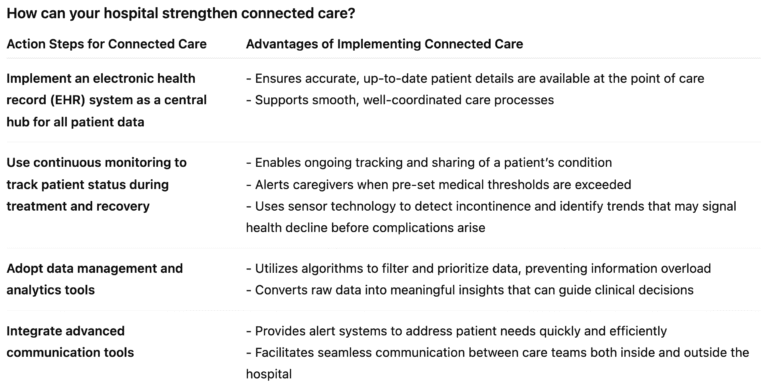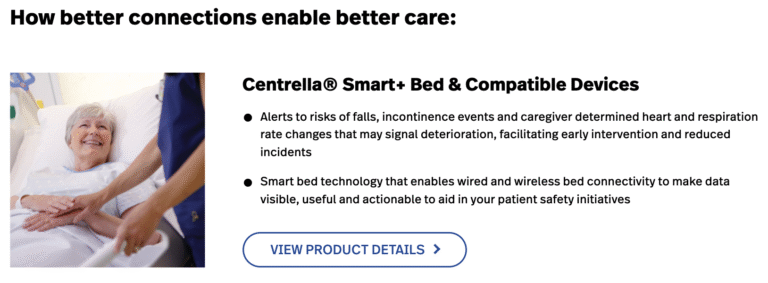How Connected Care Can Transform Patient Care
In modern healthcare, technology plays a role in nearly every stage of patient care. The question is how to harness its full potential to elevate the patient experience. From electronic health records (EHRs) to round-the-clock patient monitoring and intelligent medical devices, these tools have become deeply embedded in clinical workflows.
When these technologies are linked together and connected with care teams, they form an integrated network that can help reduce errors, improve collaboration, and speed up response times.¹–³ This concept — known as connected care — relies on multiple interoperable systems working together to ensure that vital patient information is always accessible when it’s needed most.
The ultimate aim is to enhance patient outcomes. By continuously gathering and transmitting real-time patient data, connected systems give clinicians the ability to access accurate information instantly and make informed decisions without delay.
With close to 95% of hospitals now using EHRs,⁴ many facilities have already laid the groundwork for connected care. Building on this, hospitals can integrate additional devices and platforms, moving closer to a fully connected environment.
One example is continuous monitoring technology, which can wirelessly track heart and respiratory rates in real time. When these readings go beyond preset safety thresholds, automated alerts are sent to the appropriate medical staff.⁵ This early-warning capability means potential complications can be identified well before they escalate — crucial when 70–80% of patients display changes in vital signs at least six hours prior to a serious event.⁶,⁷ Acting on these early indicators can accelerate treatment and improve recovery outcomes.⁵
EHRs and continuous monitoring are only part of the picture. Many hospitals are also adopting smart bed technologies, sensor-based surfaces, and advanced communication systems that share information seamlessly. When combined into a connected care ecosystem, these solutions can significantly enhance the way care teams operate and ultimately improve patient safety and treatment results.¹–³,⁵
Connected Care in Action: Case Study
A large-scale study involving more than 7,500 patients found that contact-free, continuous patient monitoring delivered significant improvements in both clinical outcomes and operational efficiency within the hospital setting.⁵
Improved Treatment Outcomes
In the medical-surgical unit, the introduction of continuous monitoring without physical contact resulted in a 67% decrease in cardiac arrest incidents. This improvement was largely attributed to the ability to transfer patients to the ICU sooner, based on early signs of deterioration, before a critical event occurred.
Faster Recovery and Shorter Stays
Following the adoption of continuous monitoring, the study observed:
A 45% reduction in ICU length of stay for medical-surgical patients who were transferred. Early recognition and intervention likely prevented further decline, enabling faster stabilization.
A 9% decrease in the average medical-surgical unit stay, possibly due to earlier ICU transfers and quicker initiation of appropriate treatment.
These results suggest that early detection and timely escalation of care can play a pivotal role in reducing complications, shortening recovery times, and enhancing overall patient flow within the hospital.

Summary:
- Connected care provides help to hospitals, caregivers and patients by:
- Supporting connections between systems to collect, transmit and make purposeful use of data
- Connecting care teams so they all have the most current patient information
- Continuous monitoring is one example of connected care that can enhance patient outcomes


References
1. Meccariello M, Perkins D, Quigley LG, Rocak A, Qui J. Vital time savings: Evaluating the use of an automated vital signs documentation system on a medical/surgical unit. J Healthc Inf Manag. 2010;24(4):46-51.
2. CareAware VitalsLink : Prepared by Cerner Corporation. 2013.
3. Fieler VK, Jaglowski T, Richards K. Eliminating errors in vital signs documentation. Comput Informatics Nurs. 2013;31(9):422-427.
4. Parasrampuria S, Henry J. Hospitals’ use of electronic health records data, 2015–2017. Onc Data Brief, no 46. 2019. Office of the National Coordinator for Health Information Technology; Washington, DC. Available at: https://www.healthit.gov/sites/default/files/page/2019-04/AHAEHRUseDataBrief.pdf. Accessed January 23, 2020.
5. Brown H, Terrence J, Vasquez P, Bates DW, Zimlichman E. Continuous monitoring in an inpatient medical-surgical unit: A controlled clinical trial. Am J Med. 2014;127(3):226-232.
6. Rose MA, Hanna LA, Nur SA, Johnson CM. Utilization of electronic modified early warning score to engage rapid response team early in clinical deterioration. J Nurses Prof Dev. 2015;31(3):E1-E7.
7. Subbe CP, Kruger M, Rutherfor P, Gemmel L. Validation of a modified early warning score in medical admissions. QJM. 2001;94(10):521-526.